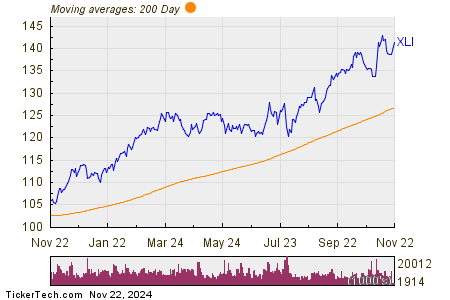XLI Sees Significant Inflows as Markets Adjust
Investors Show Confidence in Industrial Select Sector SPDR Fund
In a recent analysis of week-over-week changes in ETFs, one fund stands out: the Industrial Select Sector SPDR Fund (Symbol: XLI). This fund experienced an inflow of approximately $211.0 million, leading to a 1.0% increase in outstanding units, rising from 152,026,000 to 153,526,000. Today’s trading has seen some of XLI’s key stocks perform well: Honeywell International Inc (Symbol: HON) is up about 0.9%, Eaton Corp plc (Symbol: ETN) is up approximately 1%, and Union Pacific Corp (Symbol: UNP) has seen a 1.3% increase. For those interested in more details, a complete list of holdings can be found on the XLI Holdings page.
The chart below tracks the one-year price performance of XLI alongside its 200-day moving average:

According to the chart, XLI’s low over the past year was $105.34 per share, while its high reached $143.71. The most recent trade price stands at $141.64, indicating resilience within the current trading range. Analyzing the recent share price in relation to the 200-day moving average may offer insights for potential investors.
Exchange-traded funds (ETFs) function similarly to stocks; however, investors buy and sell “units” rather than traditional shares. These units can be traded like stocks but can also be created or destroyed based on demand. Each week, we observe week-over-week changes in shares outstanding to identify ETFs with significant inflows (which indicate many new units created) or outflows (indicating many old units destroyed). The creation of new units necessitates the purchase of the ETF’s underlying holdings, while the destruction of units entails selling those holdings. Thus, significant inflows or outflows can impact the performance of individual components within ETFs.
![]() Discover 9 Other ETFs with Notable Inflows »
Discover 9 Other ETFs with Notable Inflows »
Also see:
- Energy Stocks You Can Buy Cheaper Than Insiders Did
- OCUL Price Target
- Funds Holding ATL
The views and opinions expressed herein are those of the author and do not necessarily reflect the views of Nasdaq, Inc.

